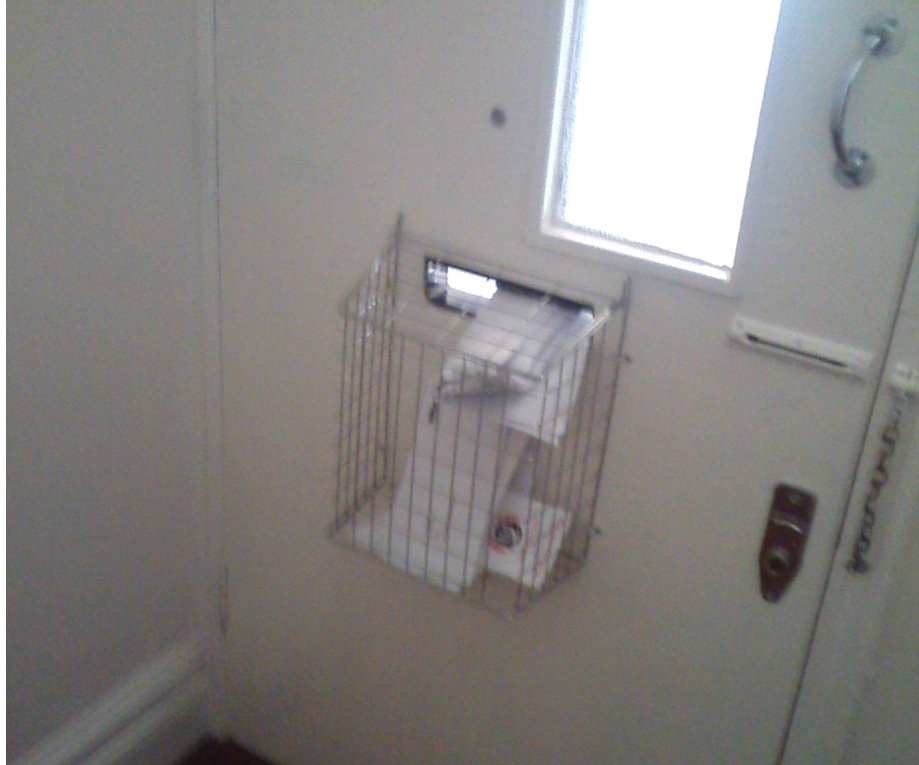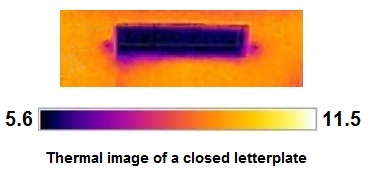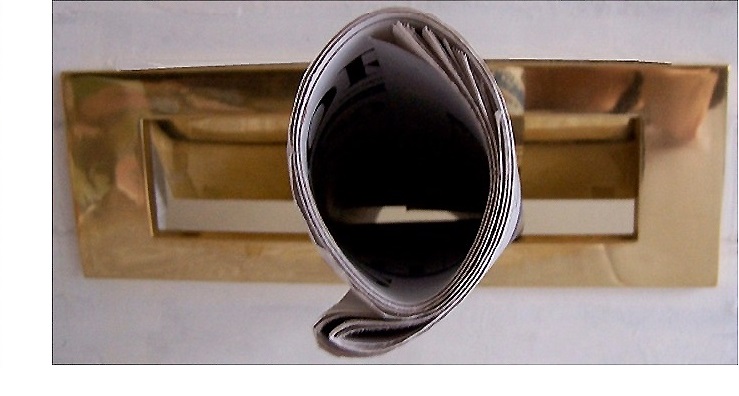
Heat loss and carbon footprint
start at your letterbox Consumer
Report advice: 'Saving money on your energy bill is not the reason to replace your
windows - it could take decades to recoup the thousands of pounds you'll spend
on new windows and installation.'
This
is in startling contrast with insulating a letterbox. Can we afford to ignore a 6% savings in the property energy bills by simply fitting IdealGuard™ to insulate the letterbox at low cost?
Especially now, when energy costs predicted to be capped at £2,800 a year for the average home by October 2022.
A letter plate exposes the premises and its occupants to all four main risks as defined by the Insurance industry: fire, water damage, malicious damage, and weather-related damage. The thermal resistance of the flap is nearly nonexistent. Door thermal imaging shows that the house energy is still lost through the closed letter plate. Imagine what happens when the flap is open for hours for whatever reason, like when a newspaper or mail items are rolled up and left inside.
For average weather conditions in the UK, nearly 3kW of house heat can be lost through the open letter plate
The letterbox draught-proofing only works with the closed flap and only to a certain extent. When a brush strip draught excluder is fitted over the letter plate, it can be difficult to push letters, newspapers and magazines fully through. It creates a stronger draught than before the brush was fitted. With junk mail, this situation is almost the norm. A tight or secondary flap cannot stop this draught either.
Millions of UK properties waste money on their energy bills and cause extra CO2 emissions into the atmosphere.
'Ha! Just had the classic experience of returning home to find the hallway like a fridge. Culprit? The new telephone directory stuck in the door creating about 16 sq. inches of hole to the outside -1ºC. Well, look at it this way: The clown who shoved it into the door saved a hell of a lot of energy by not exerting him or herself and pushing it all the way through. It needed about a whisper of a push to clear the last offending 1/4".' With
energy bills continuing to rise and new energy-efficiency standards and regulations, there is a need to make
domestic properties more energy-efficient and improve their re-sale
value. Doors U-value To understand the door's energy efficiency, one needs to look at its U-value. The U-value is an essential characteristic in BS EN 14351 Part 1. From 1st July 2013, it is mandatory under the CPR (Construction Products Regulation) that new external pedestrian doorsets are CE marked with their U-values included in the door manufacturer's DoP (Declaration of Performance) and must meet the strict U-values heat loss standards of the Building Regulations 2010 Part L. Except for very limited circumstances, it is not possible to comply with the Building Regulations by declaring the centre pane U-value. For the most part, the U-value must relate to the whole doorset and the U-values declared by door manufacturers would be misleading if the effect of the letter plate is not taken into consideration. For example, with 4" x 12" Victorian type letter plate and only 1/3 of its aperture open for just two hours a week (as it may happen when it has a draught excluder, which is jammed by mail items), the area-weighted U-value for the door would be 2.2W/m2K instead of the manufacturer's declared 1.8W/m2K. So, even in this conservative example, the door U-value will be 22.2% higher than declared. Such doors are not compliant with the Building Regulations 2010 Parts L and this problem must be sorted out by the letter plate insulation, not just draught-proofing. With insulation provided by fitting IdealGuard™ secure by design multifunctional eco letter box, the door U-value will not be affected by the letter plate. Apart from delivering compliance with the mandatory legislation, letter plate
insulation would make your home more comfortable in winter when you can
physically feel the draughts in the house with the associated discomfort and getting colds, never mind higher bills.
Savings on household energy bills can be substantial by insulating the letterbox with IdealGuard™ secure by design multifunctional eco letter box For average weather conditions in the UK, the letter plate insulation would allow preventing 2.8kW house heat loss through the fully open 4" x 12" letter plate and 0,55Kg/h CO2 emissions (1.9kW and 0.38Kg/h through 2" x 8" letter plate) (based on SAP-2009_9-90 and The Engineering ToolBox.com). To put it into perspective, gas oven energy consumption on average is 1.52 kWh per use, while for electric tumble dryer it is 2.50 kWh per use. Do not be fooled by the promises of 'energy-efficient' or 'eco' doors If you are not so keen on paying extra for heating, then look for whole-door U-value. IdealGuard™ fitting is a tried-and-true integrated solution for draught proofing and insulation of letterboxes The
PROJECT demonstrated how adopting this cost-effective solution had a significant effect. Despite rising energy prices, the IdealGuard™ secure by design multifunctional eco letter box retrofit resulted in around
6% average annual savings on monitored property energy bills, as well as reduction in
CO2 emissions around 300Kg. Energy Performance Certificate
By law, all domestic and commercial buildings in the UK available to buy or rent must have an Energy Performance Certificate (EPC). EPCs tell how energy efficient a building is and give it a rating from A (very efficient) to G (inefficient). There are regulations effective from 1st April 2016 under which a tenant can apply for consent to carry out energy efficiency improvements in privately rented properties. From 1st April 2018, there is a requirement for any properties rented out in the private rented sector to normally have a minimum energy performance rating of E on the EPC. Misleading doors U-values would cause inaccuracy in calculating the property EPC and Design Emissions Rate (DER), which are used for identifying the energy efficiency levels of a property. As a result, the property will not be assessed correctly, and this can affect the rating of the property and its market value. In the worst-case scenario, the property seller and the EPC assessor are risking getting sued. The installation of IdealGuard™ secure by design multifunctional eco letter/mail box eliminates these issues by ensuring full letter plate insulation without disrupting mail deliveries. In fact, by improving the property's energy efficiency, IdealGuard™ secure by design multifunctional eco-product will add value to the property. Since insulation works to stop heat loss, it is considered one of the most cost-effective ways of saving house energy. It is logical to start energy-efficiency improvements with those products and technologies that are most cost-effective. Using advanced energy-saving technologies to compensate for poor levels of letter plate insulation is an inappropriate trade-off, which is discouraged by Building Regulations. A single measure retrofit does not deliver. An integrated approach is necessary. Therefore, it makes sense to insulate the letterbox before, or alongside, the installation of other products/technologies. Fitting IdealGuard™ secure by design eco letter box for draughtproofing and insulating the letter plate will also improve the property's fire safety, security, and health

